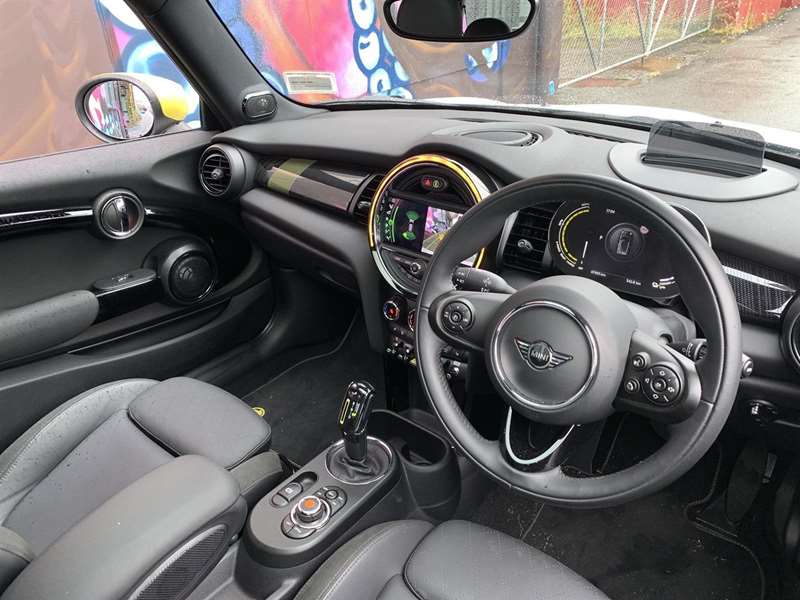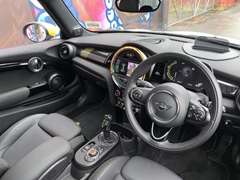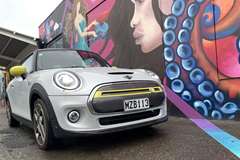BMW Group’s ‘‘Big Green Plan’’ is certainly something to behold; it is dramatically ramping up its electric car offerings, with an ambitious 10-year growth strategy.
Having already committed to offering plug-in hybrid versions of every existing model in its line-up, BMW’s plan calls for an increase in pure-electric offerings, which will initially include at least nine new models. The aim is to sell more than 4.6 million EVs within the next 10 years, along with three million-plus plug-in hybrids.
As for BMW offshoot Mini? Two uniquely-styled sports utilities are under development, and it’s also likely that there will be a continued development programme for the model that is the focus of this test, the $59,900 Cooper SE First Editionthree-door hatch, aka the ‘‘Mini Electric’’.
This model is giving BMW New Zealand huge confidence about the public taste for small electric cars — the first shipment was, with exception of the press car, sold before it arrived and there’s a waiting list for future supply.
The appeal is that it’s not a be-all, rather it’s a car that fills a specific role. Being small, it doesn’t have a massive range, so it’s patently not set to lay down distance-driving records. But that’s not really an issue. The aim here is to build upon the chic, city-centrics that have historically made all properly small Minis so charming, and the new model does so quite brilliantly.
Its battery is sandwiched into the floor and a 137kW electric motor drives the frontwheels via a single-ratio automatic transmission. So, as much as it comes across as being a fun car, it is a serious step towards the electric future in which all car makers must fully engage.
In saying that, the buy-in does anticipate acceptance that it’s an expensive small car, even with the cost saving of employing many i3 parts.
And its has a range noticeably smaller than other electric offerings occupying the same price bracket.
Standard estimates of range
— such as the WLTP (worldwide harmonised light vehicle test procedure) figures that are often quoted —need to be taken with a grain of salt but, for reference, the Hyundai Kona’s range by that measurement is 449km, the Nissan Leaf’s is 270km, and the Renault Zoe’s is 300km (climbing to 390km in the new-gen model coming soon). The Cooper’s WLTP range is 235km but, in my experience, even that’s not achievable.
The car was picked up fully-charged on a warm morning. The computer predicted a driving range of 173km before recharge.
The first test drive was the longest: a 165km open-road run. I also put in around 40km of urban driving first which didn’t seem to reduce the driving range.
When I finally hit the 100kmh sector of the test, the computer suggested an ability to complete the journey with 10km to spare.
After the test, I plugged it in
— I don’t have a home charger so it drew off a normal wall socket. Recharging the battery to 100% took eight hours, after which the car predicted a range of 186km.
The rest of the test period followed a similar formula: drive around all day, mainly short journeys, recharge at night. Oddly, every time the battery recharged, the trip computer estimated a slightly lower range —just 160km from the final charge.
As much as a shorter-than expected range niggled, it never actually annoyed and certainly didn’t lessen the overall enjoyment factor.
It did, however, cement the impression that the Mini Electric is a car aimed at urban commuters who don't face long daily journeys and, perhaps more to the point, want an electric car to be stylish.
And it fills that role admirably.
As for the money? Mini has become a premium brand and it’s only fair to acknowledge that even the cheap models don’t feel budget. You get top-quality content and an impressive equipment level. The test car was in ‘‘First Edition’’ trim that included a digital instrument cluster and large central touchscreen, a head-up display, cruise control and dual-zone air conditioning (which uses heat pump technology), heated seats, keyless entry, wireless phone charging, reversing camera with front and rear parking sensors and driver assistance features such as speed limit and traffic sign information, automatic emergency braking for pedestrians and high-beam assistance. It also ran a Harman/Kardon sound system and featured a panoramic glass sunroof.
Drawbacks? The biggest issue with a three-door Mini Hatch is that the rear passenger space is useless. It's best to only think of the back seats as somewhere to throw a bag.
The boot is the same as any other Mini hatch — shallow with a capacity of 211 litres — so carrying anything beyond a few shopping bags is going to require some planning. What is useful is the additional bit of storage under the boot floor; this is where the charging cable will live.
By the way, it’s easy to pick this particular Mini is the electric model: There are ‘‘E’’ badges on either end and embossed in the battery charge port cap, the wheel spokes are designed to resemble a three-pin plug socket and grille and door mirrors are an energetic yellow colour. The grille is also blanked-off.
There’s another small giveaway: to allow for the drivetrain, the Electric sits 18mm taller than a regular hatch, a fact that is rather well disguised as modified wheel arches and sill covers hide the difference.
The ‘‘Mini-ness’’ to how it drives and performs comes through, even with the additional 225kg weight from the battery and other powertrain-related parts.
The fact that the majority of that weight is set low in the chassis means the extra burden isn't all that apparent. If anything, the lower centre of gravity improves that grippy, go-kart feeling that Mini is known for. The steering is nicely weighted, with that slightly heavier-than-normal feel that is a signature of sporty Minis.
Ride quality is not generally great with Minis, but it’s not bad here. We’re not talking magic carpet ride, but the suspension has clearly been recalibrated.
A top speed of 150kmh isn't particularly quick, but the Mini Cooper SE is actually quite brisk in the speed bands that matter. The initial stepoff is decent —0-100kmh in 7.3 seconds — and it maintains that sense of urgency around city streets. The four drive modes vary the amount of power available, but I ran a fair distance at 100kmh in the ‘‘eco’’ mode and it didn’t feel tardy. Change into Sport and it is far more enlivening, though this also draws more power.
The only element absent is an aural signature, but the car is far from anonymous — it looks great. Beyond that, it is fun to drive, acquits itself perfectly well as a chic innercity plaything, and can also sustain open-road trips, albeit with limited range between recharges.
Life is going to be different in an electric age, but cars like this will at least keep it interesting.












